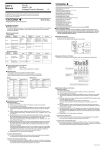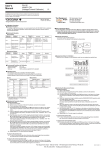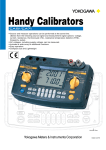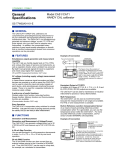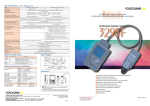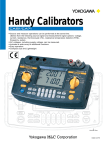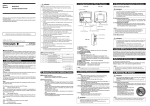Download User`s Manual
Transcript
CA12E HANDY CAL (Temperature Calibrator) User’s Manual Yokogawa Meters & Instruments Corporation -2- In addition to this User’s Manual, there is another manual for the instrument, IM CA12E-01E, which provides instructions for its safe use and explains its functions. Refer to it as needed. IM CA12E-02E 2nd Edition Nov. 2006 (KP) 8. Calibration Procedure ■ Calibration Procedure To maintain a high level of accuracy, it is recommended that the CA11E HANDY CAL be calibrated annually. The “Selecting the Standards” section below presents calibration methods using the recommended standards. ■ Selecting the Standards Source feature Items to be calibrated Names of standards Range Measuring range Accuracy International Sales Dept. Tachihi Bld. No.2, 6-1-3, Sakaecho, Tachikawa-shi,Tokyo 190-8586 Japan Phone: 81-42-534-1413, Facsimile: 81-42-534-1426 YOKOGAWA CORPORATION OF AMERICA (U.S.A.) Phone: 1-770-253-7000 Facsimile: 1-770-251-2088 YOKOGAWA EUROPE B. V. (THE NETHERLANDS) Phone: 31-334-64-1611 Facsimile: 31-334-64-1610 YOKOGAWA ENGINEERING ASIA PTE. LTD. (SINGAPORE) Phone: 65-6241-9933 Facsimile: 65-6241-2606 YOKOGAWA AMERICA DO SUL S. A. (BRAZIL) Phone: 55-11-5681-2400 Facsimile: 55-11-5681-1274 YOKOGAWA MEASURING INSTRUMENTS KOREA CORPORATION (KOREA) Phone: 82-2-551-0660 to -0664 Facsimile: 82-2-551-0665 YOKOGAWA AUSTRALIA PTY. LTD. (AUSTRALIA) Phone: 61-2-9805-0699 Facsimile: 61-2-9888-1844 YOKOGAWA INDIA LTD. (INDIA) Phone: 91-80-4158-6000 Facsimile: 91-80-2852-1441 YOKOGAWA SHANGHAI TRADING CO., LTD. (CHINA) Phone: 86-21-6880-8107 Facsimile: 86-21-6880-4987 YOKOGAWA MIDDLE EAST E. C. (BAHRAIN) Phone: 973-358100 Facsimile: 973-336100 LTD. YOKOGAWA ELECTRIC (RUSSIAN FEDERATION) Phone: 7-095-737-7868 Facsimile: 7-095-737-7869 IM3E-2006.2 ■ Notice regarding the Manual <1> The information contained in this Instruction Manual is subject to change without notice. <2> Every effort has been made to ensure that the information contained herein is accurate. However, should any concerns, errors, or omissions come to your attention, or if you have any comments, please contact us. Remarks DCV Digital multimeter 100 mV Max.110 mV (0.005%+5 µV) Model 7561 (Yokogawa) or equivalent Digital multimeter 400 Max. 440 Measuring current: 1 mA (0.005%+0.02 ) Model 7561 (Yokogawa) or equivalent CA12E Input terminal Measurement feature Items to be calibrated Names of standards Standard DC voltage generator DCV Decade resistance box 3W Lo Lo Range 100 mV 400 Generated value 100 mV 400 Accuracy L 0.01% Model 2552 (Yokogawa) or equivalent 0.01% Model 279301 (Yokogawa) or equivalent 100 mV 400 0 FS 0 mV 100 mV 0 0mV FS 400 Calibration points Standard <2>Calibration for 400- measurement • Connection method Connect the CA12E calibrator to the standard in a three-wire connection configuration for calibration as shown below: 3W Lo Lo Hi Decade resistance box 400 Standard Measurement: Calibration points DMM 2000 range CA12E ■ Calibration Points • The calibration points are as specified in the following tables. • It is possible to independently select the necessary range to be recalibrated. • Always calibrate the zero (0) point and full scale (FS) as a pair for generation. Standard Value*1 H Hi Remarks ■ Environmental Conditions for Calibration Ambient temperature: 23 1°C Relative humidity: 45 to 75% R.H Warm-up: Warm-up time as specified for the standard Source: Sensing terminal Standard Value*2 100 mV FS 100 mV 400 FS 400 *2: Set the value to the standard as specified in the table. <3>Calibration for internal RJ compensation Because this calibration requires special equipment (a K-type thermocouple and 0°C reference temperature chamber), contact the sales agent or office where the instrument was purchased, or our office. ■ Assignment of Keys for Calibration When the CA12E calibrator is in the calibration mode, keys are assigned as specified here. *1: Make adjustments to CA12E according to the reading of the standard (CA12E output value) as specified in the table. SOURCE ON ■ Calibrating the Generation Feature Operation procedure: <1> Warm up the standard. <2> Before turning on the power of the CA12E calibrator, connect it to the standard. Be sure to remove the external RJ sensor. <3> Turn on the power of the instrument. <4> Simultaneously press and hold the [▲1] and [▼4] keys (shown in the figure in the “Assignment of Keys for Calibration” section below) for about 2 seconds to enter the calibration mode. <5> Select the generation range to calibrate using the MEASURE/SOURCE selection switch and range selection rotary switch. The display unit shows “CAL,” “SOURCE,” “ON,” “0,” and the lower limit. <6> Read the output value of the CA12E using the standard (digital multimeter), and using the [▲] and [▼] adjustment keys adjust the CA12E so that the output value is set to the offset value. Then press the [▼1] input determination (ENTER) key to fix the setting. After fixing the setting, the display unit reading changes to “CAL,” “SOURCE,” “ON,” “FS,” and shows a full scale of the range. <7> Read the output value of the CA12E using the standard (digital multimeter), and using the [▲] and [▼] adjustment keys adjust the CA12E so that the output value is set to the full scale value. Then press and hold the [▼1] input determination (ENTER) key for about 1 second to fix the setting. After fixing the setting, the display unit shows “0 FS” blinking. Re-press and hold the [▼1] input determination (ENTER) key for about 1 second to write the calibration coefficients to the EEPROM of the instrument. (This overwrites the previous calibration coefficients.) When this is complete, the instrument returns to the status in Step 5. <8> Repeat Steps 5 to 7 for each range to be calibrated. To return to the previous step: <9> To return to the previous step without fixing the setting, press the [▲1] input cancellation key. Note that this is possible only before writing to the EEPROM. To return to the normal operation mode: <10>Simultaneously press and hold the [▲1] and [▼4] keys (shown in the figure in the “Assignment of Keys for Calibration” section below) for about 2 seconds, or press the [POWER] key to turn off the power once and then press it again to turn it back on. ■ Calibration Precautions <1>Calibration for 400- generation • Set resistance-measuring current to 1 mA (*) (*) Check the specifications of the digital multimeter (DMM) to be used as the standard. Example: Resistance-measuring current is 1 mA for the 2000 range of Model 7561 (Yokogawa). • Connection method Connect the CA12E calibrator to the standard in a four-wire connection configuration for calibration as shown below: CAL 0 1 2 3 4 Input cancellation key Input determination (ENTER) key Mode switching (calibration or normal) (Press and hold two keys simultaneously for 2 seconds.) Adjustment keys (six keys) Digit to be adjusted by the [▲4/▼4] adjustment keys ■ Calibrating the Measurement Feature Operation procedure: <1> Warm up the standard. <2> Before turning on the power of the CA12E calibrator, connect it to the standard. Be sure to remove the external RJ sensor. <3> Turn on the power of the instrument. <4> Simultaneously press and hold the [▲1] and [▼4] keys (shown in the figure in the “Assignment of Keys for Calibration” section below) for about 2 seconds to enter the calibration mode. <5> Select the measurement range to calibrate using the MEASURE/SOURCE selection switch and range selection rotary switch. "CAL” and “MEASURE” appear and “FS” blinks on the display unit. (If a value nearly equivalent to full scale has been input, a measured value and “FS” appear.) <6> Set up the standard in order to input the full scale value to the instrument. Wait until the reading stabilizes, then press and hold the [▼1] input determination (ENTER) key for about 1 second to fix the setting. <7> After fixing the setting, “0” and “FS” indications on the display unit start blinking. Re-press and hold the [▼1] input determination (ENTER) key for about 1 second to write the calibration coefficients to the EEPROM of the instrument. (This overwrites the previous calibration coefficients.) <8> Repeat Steps 5 to 7 for each range to be calibrated. To return to the previous step: <9> To return to the previous step without fixing the setting, press the [▲1] input cancellation key. Note that this is possible only before writing to the EEPROM. To return to the normal operation mode: <10>Simultaneously press and hold the [▲1] and [▼4] keys (shown in the figure in the “Assignment of Keys for Calibration” section below) for about 2 seconds, or press the [POWER] key to turn off the power once and then press it again to turn it back on. IM CA12E-02E <1> 9. Specifications ■ Source/Measurement Functions Accuracy: (% of set value or reading + °C, µV, or ), at 23 5°C Accuracy Range Selection TC *1 Range of Source/Measure Resolution Source *3 K -200.0 to +1372.0°C E -200.0 to +1000.0°C J -200.0 to +1200.0°C T -200.0 to +400.0°C N -200.0 to +1300.0°C R S 0 to 1768°C Measurement *4 Remarks 0.05%+1°C 0.07%+1.5°C -100°C or above 0.05%+2°C 0.07%+2°C Below -100°C 0.05%+3°C 0.07%+3°C Below 100°C 0.05%+2°C 0.07%+2°C 100°C or above 0.05%+4°C 0.07%+4°C Below 1000°C 0.1°C 1°C B +600 to +1800°C 0.05%+3°C 0.07%+3°C 1000°C or above L -200.0 to +900.0°C 0.05%+0.5°C 0.07%+1.5°C 0°C or above U -200 to +400°C 0.05%+1°C 0.07%+2°C Below 0°C -10.00 to +110.00 mV 0.05%+30 V 0.05%+30 V 0 to 400 0.05%+0.2 0.05%+0.2 *5 0.05%+0.6°C 0.05%+0.6°C*5 100 mV 400 PT100 *2 -200.0 to +850.0°C JPT100 -200.0 to +500.0°C Measurement range: 0 to 110.00 mV Excitation current *6 0.1°C 0.1 V 0.1 0.1°C Temperature coefficient: 1/10 of accuracy/°C *1: According to JIS C 1602-1995 (Reference Thermo-electromotive Force Table). L and U are determined according to the DIN standard. *2: According to JIS C 1604-1997 (Reference Resistance Table) International Practical Temperature Scale of 1968 (IPTS68) for PT100 reference resistance IPTS68 for PT100 is -200 to +650°C. *3: The TC generation accuracy does not include the RJ accuracy. The sensor output accuracy must be taken into consideration when output compensation is determined based on the RJ temperature (output compensation performed every 4 seconds). *4: When it is calculated according to the Reference Thermo-electromotive Force Table, the TC measuring accuracy includes the RJ accuracy (TC accuracy added). The terminal temperature must be stable. *5: Three-wire measurement *6: Excitation current for generation: 0.5-2 mA; Excitation current for measurement: approximately 2 mA When the excitation current is 0.1 mA, 0.05% + 1°C (0.4 ) is added, and the maximum input capacitance of the device under calibration is 0.1 µF. Four 1.5-V alkaline batteries (LR6, AA-size) or dedicated AC adapter (sold separately) Battery life: Approximately 55 hours (when running on alkaline batteries) Automatic Power Off: After a period of approximately 10 minutes with no operations Generation Signal Level Setting: By four sets of up and down keys Response of generator: Approximately 20 ms (between the time when the specified current is supplied and the time when the output value enters the accuracy range) Loading conditions: Less than 0.1 µF (DCV) Measured-value indication updating intervals: Approximately 1 second Display: 7 segments LCD Maximum allowable applied voltage: 42 V between each terminal and ground Operating temperature and humidity range: 0 to 50°C, 20 to 80% R.H. (no condensation) Storage temperature and humidity range: -20 to 50°C, 90% R.H. or less (no condensation) Dimension: Approximately 192 (H) 92 (W) 42 (D) mm (excluding protrusions) Weight: Approximately 440 g Accessories: Lead cables (B9108MT) for measurement and generation (one set, consisting of two black cables and one red cable) Terminal adapter (B9108KF) 2 manuals Optional accessories: Dedicated AC adapter (A1020UP: AC100 V, A1022UP: AC120 V, B9108WB: AC 220-240 V) Carrying case (B9108NK) Rubber boot (93038) Strap (97040) Accessory case (B9108XA) RJ sensor: reference junction compensation (B9108WA) Safety standards: EN61010-1 (only AC adapter B9108WB) (A1020UP and A1022UP are excluded.) EMC standards: EN61326 ClassB EN55011 ClassB Group1 EN61000-3-2 EN61000-3-3 Immunity: EN61326 Performance criterion under immunity test environments: B (self-returnable performance deterioration) Test conditions of EMC and Immunity standards: AC adapter (B9108WB), Lead cables (B9108MT) and RJ sensor (B9108WA) are used. 10. How to Use the Carrying Case and Rubber Boot ■ Carrying case (B9108NK) The carrying case (B9108NK) may be used as follows: (1) Undo the fasteners on the top and sides of the case cover to open it. (2) With the fastener on the logoside of the case centered, lift the cover and pivot it to the side and under the case itself. (3) Re-do the fasteners at the top and sides of the cover. Power supply: Note: The fastener on the logo-side cannot be undone. ■ Rubber boot (93038) ■ Anti-skid pad Anti-skid pad (supplied) The optional rubber boot provides shock protection and can be used with a strap. Note: When using the instrument with a rubber boot, the anti-skid pad at the bottom is not needed. When used without a rubber boot in a leaning position, the supplied anti-skid pad should be used. ■ Specifications of the External RJ Sensor *3 Measuring range -10 to +50°C (Model: B9108WA) Accuracy (when combined with the instrument) 18 28°C: 0.5°C Other ranges: 1°C Cord length: Approximately 1.5 m Compensation using the built-in sensor is also possible by adjusting the setting of the internal DIP switch on the instrument. IM CA12E-02E <2>


